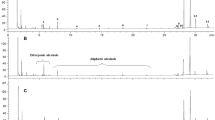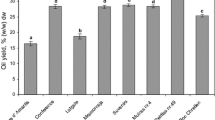Abstract
Total hydrocarbon composition and content of whole peanuts from three Tunisian varieties of peanut (two cultivars: AraC (Virginia type), AraT (Valencia type) and a wild one: AraA) were investigated during maturation. The results show that 30 hydrocarbons were identified from the wild AraA species, while only 27 hydrocarbon were detected in the cultivar ones. The hydrocarbon fraction is essentially composed of squalene, n-alkenes especially nC14=, nC16=, nC18=, nC20= and nC22=, n-alkanes such as nC16, nC17, nC18, nC25, nC26 and nC27, and branched saturated hydrocarbon noted (HC1, HC2 and HC3). Among the hydrocarbon components, generally the wild variety AraA presents the highest content of phytochemical squalene during maturation, whereas a maximum was detected from cultivar AraT at 12 days after podding (815.45 mg/100 g of oil). At maturity, the maximum level is reached at about 346.74 mg/100 g of oil for AraA. During maturity, wild AraA is considered to be an excellent source of squalene like olive and pumpkin oil.







Similar content being viewed by others
Abbreviations
- AraA:
-
Arachis Arbi (wild)
- AraC:
-
Arachis Chounfakhi (cultivar)
- AraT:
-
Arachis Trabelsia (cultivar)
- BUHC:
-
Branched unsaturated hydrocarbon
- BSHC:
-
Branched saturated hydrocarbon
- DAP:
-
Days after podding
- GC-FID:
-
Gas chromatography- flame ionization detector
- GC/MS:
-
Gas chromatography-mass spectrometry
- HC:
-
Hydrocarbon
- HMW:
-
High molecular weight
- IS:
-
Immature stage
- LUHC:
-
Linear unsaturated hydrocarbon
- M:
-
Maturity
- MIS:
-
Middle stage
- SHC:
-
Saturated hydrocarbon or n-alkanes
- UHC:
-
Unsaturated hydrocarbon or n-alkenes
References
Bortolomeazzi RA, Berno P, Pizzale L, Conte LS (2001) Sesquiterpene, alkenes, and alkanes hydrocarbons in virgin olive oils of different varieties and geographical origins. J Agric Food Chem 49:3278–3283
Jasperson H, Jones R (1947) Some unsaponifiable constituents of the deodorization distillates of vegetable oils. J Soc Chem Ind 66:13
Moreda W, Pérez-Camino MC, Cert A (2001) Gas and liquid chromatography of hydrocarbons in edible vegetable oils. J Chromatogr A 936:159–171
Iyer S, Millar T, Clemens S, Zachgo S, Giblin D, Taylor M, Kunst L (1998) Advances in plant lipid research. Universidad de Sevilla, Spain 87
Bognar AL, Paliyath G, Rogers L, Kolattukudy PE (1984) Biosynthesis of alkanes by particulate and solubilized enzyme preparations from pea leaves (Pisum sativum). Arch Biochem Biophys 235:8–17
Webster L, Simpson P, Shanks AM, Moffat CF (2000) The authentication of olive oil on the basis of hydrocarbon concentration and composition. Analyst 125:97–104
Capella P, Fedeli E, Cirimele M, Jacini G (1963) The hydrocarbon fraction of virgin olive oil and changes resulting from refining. Riv Ital Sostanze Grasse 40:603
Lanzon A, Albi T, Cert A, Gracian J (1994) The hydrocarbon fraction of virgin olive oil and changes resulting from refining. J Am Oil Chem Soc 71:285–291
Goh SH, Gee PT (1986) Non-carotenoid hydrocarbons in palm oil and palm fatty acid distillate. J Am Oil Chem Soc 63:226
Kaiya A (1990) The use of natural squalene and squalane, and the latest situation of the raw materials (in Japanese). Yukagaku 39:525–529
Malecka M (1994) The effect of squalene on the thermostability of rapeseed oil. Nahrung 38:135–140
Smith TJ (2000) Squalene: potential chemo preventive agent. Exp Opin Invest Drugs 9:1841–1848
Psomiadou E, Tsimidou M (1999) On the role of squalene in olive oil stability. J Agric Food Chem 17:4025–4032
Cherif AO (2012) Phytochemicals components as bioactive foods. In: Bioactive compounds in phytomedicine, pp 113–124. ISBN: 978-953-307-805-2. http://www.intechopen.com/articles/show/title/phytochemicals-components-as-bioactive-foods
Tuberoso CIG, Kowalczyk A, Sarritzu E, Cabras P (2007) Determination of antioxidant compounds and antioxidant activity in commercial oilseeds for food use. Food Chem 103:1494–1501
Official Methods and Recommended Practices of the American Oil Chemist’s Society (1989) AOCS, Champaign, IL, Method Ce-66
NIST 05 Chem-station Library. http://www.sisweb.com/software/ms/nist.htm
R version 2.10 (2009) The R foundation for statistical computing. http://www.r-project.org
Venables WN, Ripley BD (2002) Modern applied statistics with S. Springer, Berlin
Gabriel KR (1971) The biplot graphical display of matrices with application to principal component analysis. Biometrika 58:453–467
McGill AS, Moffat CF, Mackie PR, Cruickshank P (1993) The composition and concentration of n-alkanes in retail samples of edible oils. J Sci Food Agric 61:357–362
Augusto L, Tomas A, Arturo C, Jaime G (1994) The hydrocarbon fraction of virgin olive oil and changes resulting from refining. J Am Oil Chem Soc 71(3):285–291
Harrabi S, Boukhchina S, Mayer PM, Kallel H (2009) Policosanol distribution and accumulation in developing corn kernels. Food Chem 115:918–923
Cherif OA, Trabelsi H, Ben Messaouda M, Kaabi B, Pellerin I, Boukhchina S, Kallel H, Pepe C (2010) Gas chromatography-mass spectrometry screening for phytochemical 4-desmethylsterols accumulated during development of Tunisian peanut kernels (Arachis hypogaea L.). J Agric Food Chem 58(15):8709–8714
Favero AP, Moraes SA, Garcia AAF, Valls JF, Vello NA (2009) Characterization of rust, early and late leaf spot resistance in wild and cultivated peanut germplasm. Sci Agric 66:110–117
Cherif AO, Ben Messaouda M, Kaabi B, Pellerin I, Boukhchina S, Kallel H, Pepe C (2011) Characteristics and pathways of bioactive 4-desmethylsterols, triterpene alcohols and 4a-monomethylsterols, from developing Tunisian cultivars and wild peanut (Arachis hypogaea L.). Plant Physiol Biochem 49:774–781
Guinda A, Lanzon A, Albi T (1996) Differences in hydrocarbons of virgin olive oils obtained from several olive varieties. J Agric Food Chem 44:1723–1726
Volkman JK (2005) Sterols and other triterpenoids: source specificity and evolution of biosynthetic pathways. Org Geochem 36:139–159
Herchi W, Harrabi S, Rochut S, Boukhchina S, Kallel H, Pepe C (2009) Characterization and quantification of the aliphatic hydrocarbon fraction during linseed development (Linum usitatissimum L.). J Agric Food Chem 57:5832–5836
Yang J (2009) Brazil nuts and associated health benefits: a review. Food Sci Technol LWT 42:1573–1580
Acknowledgments
The authors would like to thank Mr. M. El Chikh (Hammam el Ghezaz, Tunisia) for his technical assistance in conducting the culture of the peanuts.
Author information
Authors and Affiliations
Corresponding author
About this article
Cite this article
Cherif, A.O., Ben Messaouda, M., Pellerin, I. et al. Screening and Profiling of Hydrocarbon Components and Squalene in Developing Tunisian Cultivars and Wild Arachis hypogaea L. Species. J Am Oil Chem Soc 90, 675–686 (2013). https://doi.org/10.1007/s11746-013-2212-5
Received:
Revised:
Accepted:
Published:
Issue Date:
DOI: https://doi.org/10.1007/s11746-013-2212-5




